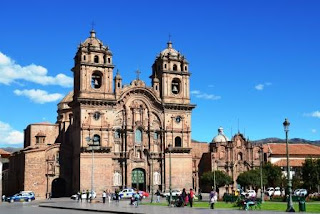Cuzco is an old Inca city. It was founded before the Inca times and was made capital of the Inca Empire. It was built to resemble a Puma, where the head is formed by a place called Sacsayhuaman on the northern outskirts of the city. This place was an important military point during the wars against the Spanish. It also contained some temples, including a lightning temple, which forms the teeth of the Puma. English speaking tourists seem to remember the place due to its name, which can be pronounced as "Sexy woman".
The Incas spoke quechua, and since this was a spoken language and not written, many of the names are nowadays spelled in different ways in different places. Cuzco can for example also be spelled Cusco. We also saw the "Sexy woman" being spelled many different ways. The most interesting about this is that the Incas might not even have been called Incas, but rather Enkas, Ingas or something similar. On the other hand, there were actually only very few Incas. It was only the rulers who were called Incas and therefore only about a dozen people have ever really been known as Incas.
Picture of the Municipal palace in plaza Regocijo. The flag at the top of the building (also shown in the picture below to the left) can be mistaken for the gay flag, but is the flag of Cuzco. The picture below to the right is of a statue in the middle of Plaza de Armas.

The Cathedral is located on the Plaza de Armas. It contains many artifacts, for example a cross that was brought over from Europe by the Spaniards when they were conquering the Peruvians and "convincing" them to become Christian. It also contains the Black Christ, which is a wooden crucifix that has turned black from many years of exposure to candle light. It is also called the Lord of earthquakes after an image of Christ supposedly stopped an earthquake from devastating Cuzco in the middle of the 17th century.
The church of la compania de Jesus - the society of Jesus, also located on the Plaza de Armas.
Plaza de Armas
I'm not called Calle, but there was a Swedish street just off the Plaza del Armas.
Coricancha (or Qorikancha) was an important temple during Inca times. Many of the walls and floors were covered in solid gold and there were many gold statues in the courtyard before the Spanish arrived. They demolished the temple and instead built a church on top of the old Inca temple, keeping some of the foundations. Earthquakes have damaged the church, which has been rebuilt, but the Inca foundation still stands.
All of Peru seem to be very environmentally friendly. We saw many signs telling people to turn off lights and to save water. They also sort their thrash into organic and inorganic waste. The picture below is taken in our hotel room in Cuzco.
The highest Irish-owned pub, Paddy's, is located in Cuzco.











No comments:
Post a Comment